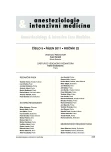The mechanism of hypotension with intravenous paracetamol in the critically ill
Authors:
Krajčová Adéla 1; Matoušek Vojtěch 1; Duška František 1,2
Authors‘ workplace:
3. lékařská fakulta Univerzity Karlovy, Praha
1; Klinika anesteziologie a resuscitace Fakultní nemocnice Královské Vinohrady, Praha
2; Ústav biochemie a molekulární biologie 3. LF UK, Praha
3
Published in:
Anest. intenziv. Med., 22, 2011, č. 5, s. 266-271
Category:
Intensive Care Medicine - Original Paper
Overview
Objective:
To elucidate the mechanism of hypotension caused by intravenous administration of paracetamol (acetaminophen) in the critically ill.
Design:
Prospective, observational, cross-over study.
Setting:
Intensive Care Unit, University Hospital.
Methods:
Mechanically ventilated critically ill patients monitored by PiCCO who were concurrently administered i.v. paracetamol were eligible for the study. We recorded the haemodynamic indices, the core and peripheral temperatures continuously for 3 hours after the administration of paracetamol or a control drug known not to influence the haemodynamics.
Results:
We included 6 subjects in whom we recorded 48 episodes of i. v. paracetamol administration and 35 episodes of control drug administration. The haemodynamic parameters were not different at baseline (p = NS) and the administration of the control drug did not result in any changes in the haemodynamics. After i. v. paracetamol administration, mean arterial pressure dropped by 7% (p < 0.001) with a nadir in the 19th minute, caused by a small but statistically significant decrease in both cardiac output and systemic vascular resistance by 5% (p < 0.001). The haemodynamic response to paracetamol is inter-individually variable and dependent on body temperature. In pyrexial patients, paracetamol has negative inotropic effects (cardiac output decreases by 10%), whilst in afebrile subjects, vasodilation predominates. In pyrexial patients we observed a narrowing of the gradient between the core and skin temperatures suggesting skin vasodilation, but this was not followed by changes of the systemic vascular resistance.
Conclusion:
Intravenous paracetamol alters the haemodynamics in a subset of critically ill patients by decreasing both the cardiac output and systemic vascular resistance. Vasodilation is more pronounced in afebrile subjects, whilst a negative inotropic effect predominates in pyrexial patients.
Keywords:
paracetamol – acetaminophen – adverse effect – hypotension – systemic vascular resistance – cardiac output
Sources
1. Stricker, B. H. et al. Acute hypersensitivity reactions to paracetamol. Brit. Med. J. (Clinical Research Ed.), 1985, 145, p. 938–939.
2. Brown, G. Acetaminophen-induced hypotension. Heart & Lung, 1996, 25, p. 137–140.
3. Boyle, M. et al. Paracetamol administration is associated with hypotension in the critically ill. Australian Critical Care, 1997, 10, p. 120–122.
4. Mrozek, S. et al. Acetaminophene-induced hypotension in intensive care unit: a prospective study. Annales Françaises d’Anesthésie et de Réanimation, 2009, 28, p. 448–453.
5. Hersch, M. et al. Intravenous paracetamol (prodafalgan) causes hypotension in critically ill patiens. Critical Care, 2004, 8, p. 244.
6. de Maat, M. et al. Paracetamol for intravenous use in medium - and intensive care patients: pharmacokinetics and tolerance. Eur. J. Clin. Pharm., 2010, 42, p. 713–719.
7. Danguy, M. et al. Acetaminophen-induced hypotension after intravenous and oral administration. Annales Françaises d’Anesthésie et de Réanimation, 2010, 29, p. 313–314.
8. Allegaert, K. et al. Haemodynamics of intravenous paracetamol in neonates. Eur. J. Clin. Pharm., 2010, 42, p. 855–858.
9. Bendjelid, K. et al. Systemic arterial hypotension induced by paracetamol adminitration: nurse’s anecdotes or facts from intensive care unit? Annales Françaises d’Anesthésie et de Réanimation, 2000, 19, p. 499.
10. Uživatelská příručka PiCCO2 [online] 10-2008 [cit. 2011-05-31] Dostupné na WWW: <http://www.pulsion.com/fileadmin/ pulsion_share/Products_Flyer/PiCCO2_US_ALL/PiCCO2_Booklet_E_MPI851105_US_R01_091008_low.pdf>
11. Joly, H. R., Weil, M. H. Temperature of the great toe as an indication of the severity of shock. Circulation, 1969, 19, p. 131–138.
12. Ramsay, M. A. et al. Controlled sedation with alphaxalone-alphadolone. Brit. Med. J., 1974, 134, p. 656–659.
13. Boyle, M. et al. Paracetamol induced skin blood flow and blood pressure changes in febrile intensive care patients: An observational study. Australian Critical Care, 2010, 23, p. 208–214.
14. Johnson, J. M., Kellogg, D. L. jr. Thermoregulatory and thermal control in human cutaneous circulation. Frontiers in Bioscience, 2001, 6, p. 825–853.
15. Holowatz, L. A. et al. The human cutaneous circulation as a model of generalized microvascular function. Journal of Applied Physiology, 2008, 50, p. 370–372.
Labels
Anaesthesiology, Resuscitation and Inten Intensive Care MedicineArticle was published in
Anaesthesiology and Intensive Care Medicine

2011 Issue 5
Most read in this issue
- Ultrasound guided medial cervical plexus blockade
- Does measuring the intracranial pressure influence survival rates in patients with brain injury?
- The mechanism of hypotension with intravenous paracetamol in the critically ill
- Fibrinolysis in cardiac surgery in the post-aprotinin era
